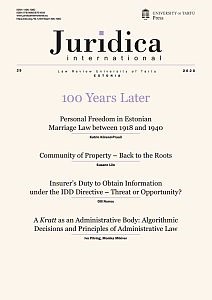Personal Freedom in Estonian Marriage Law between 1918 and 1940
DOI:
https://doi.org/10.12697/JI.2020.29.01Keywords:
inter-war period, family law, matrimonial property, gender equality, personal freedomAbstract
Although Estonia started to develop its own legal system after gaining independence in 1918, many of the old laws from the Russian Empire remained in force in the interim. Soon, Estonia started to develop its own civil code. The old Baltic Private Law Code was highly patriarchal, and various aspects of family law reform were extensively discussed throughout the 1920s and 1930s. While the need for reform was widely accepted, opinions as to its extent varied considerably: female lawyers, inspired by Scandinavian laws, fought for the greatest possible degree of freedom and equality between spouses, while conservative politicians preferred more moderate changes.
The article examines two main questions connected with the developments of those times – how much freedom the state gave to spouses for regulating their personal and proprietary relations and how much personal freedom the wife had in comparison to the husband. The norms regulating personal relations, the statutory matrimonial property regime, and the contract related to marital property are analysed in connection with efforts to identify the merits and reasonable limits of personal freedom in marriage. The family law in force in the 1920s and 1930s is compared with draft forms of the Estonian Civil Code, for uncovering how the compilers of the new version achieved balance between modern liberal ideas of personal freedom and traditional concerns about upholding stability of marriage.


